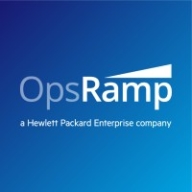

Splunk AppDynamics and OpsRamp compete in the IT monitoring and management category, with Splunk AppDynamics being preferred for its comprehensive application performance insights.
Features: Splunk AppDynamics provides deep application performance insights, allowing detailed stack trace analysis and transactional awareness. It is appreciated for tracking business transactions, end-to-end monitoring, and database insights, making it ideal for extensive application performance management. OpsRamp offers robust infrastructure monitoring capabilities and integrates well with hybrid cloud environments, providing a single-pane-of-glass view for IT operations and supporting process automation.
Room for Improvement: Splunk AppDynamics could enhance network monitoring, improve integration with technologies like Docker, and optimize licensing models. Users also seek a more intuitive interface for mobile and desktop and advanced dashboard creation options. OpsRamp could refine its ITSM integration and bolster its automation capabilities, with users noting the need for better handling of large-scale deployments and advancements in network monitoring.
Ease of Deployment and Customer Service: Splunk AppDynamics is known for easy deployment, especially in cloud settings, and offers comprehensive customer support. Its premium support options and proactive customer engagement are well-regarded. OpsRamp is noted for straightforward deployment in hybrid and cloud settings, viewed as cost-effective for infrastructure monitoring, with both products recognized for strong customer support.
Pricing and ROI: Splunk AppDynamics is seen as a premium investment, justified by its application monitoring capabilities and operational efficiencies. Users emphasize understanding licensing to avoid surprises, often reporting positive ROI. OpsRamp is regarded as more cost-effective, with a clear licensing model offering value in infrastructure monitoring, praised for extensive cloud management capabilities at a fair price.
It is important to stick with available features and provide customers with clear, precise details about what can and cannot be done to avoid anomalies.
I find the licensing model convenient and clear enough, and I have seen a return on investment with OpsRamp.
According to errors, exceptions, and code-level details related to their application performance on a daily basis, the application development team tries to help with Splunk AppDynamics to reduce errors and exceptions, which helps the end users get application availability and feel more confident.
To understand the magnitude of it, when the company asked to replace Splunk AppDynamics with another tool, I indicated that for the proposed tool, we would need five people to do the analysis that Splunk AppDynamics enables me to do.
It's very hard to find ROI because we are currently focused only on the on-premises applications.
Having a dedicated firefighter team for each MSP would be beneficial.
AppDynamics is much more helpful.
We got a contact, an account manager, to work directly with for technical support.
They help us resolve any issues raised by our team relating to operations, application instrumentation, or any other issues.
We have reached maximum capacity in our tier, and extending capacity has not been cost-effective from Splunk's perspective.
I would rate the scalability of Splunk AppDynamics as a nine out of ten.
I assess how Splunk AppDynamics scales with the growing needs of my organization as good, since we are growing and adding more servers.
It is necessary to conduct appropriate testing before deploying them in production to prevent potential outages.
There are no issues or bugs with the 20.4 version; it is very stable with no functionality or operational issues.
I can rate it nine out of ten.
Technical support should be improved.
Splunk AppDynamics does not support the complete MELT framework, which includes metrics, events, logging, and tracing for the entire stack.
If AppDynamics could develop a means to monitor without an agent, it could significantly improve application performance and reduce potential problems.
A good integration with Splunk would be very interesting, as Splunk is a good product for logs, and that part is currently missing in Splunk AppDynamics.
it does not strike me as expensive, and the licensing model is clear enough.
We completed a three-year deal for Splunk and for AppDynamics, which costs millions of dollars.
Customers have to pay a premium price, however, they receive considerable value from the product.
All these solutions at the moment are cheap, but it is like paying for insurance; you pay insurance to avoid major damage.
I have utilized OpsRamp's capability for predictive analytics, and it has been important in fostering collaboration between my IT and development teams under DevOps methodologies, where applicable.
We have multiple tools, but end users prefer to use Splunk AppDynamics because their portal navigation is very simple and clear.
The real user monitoring and digital experience monitoring effectively track actual user experience with the applications, including page loading, interaction time for both desktop and mobile applications.
The feature that I appreciate in AppDynamics Browser Real-User Monitoring is the intuitive and user-friendly dynamic mapping it creates for workflows.
| Product | Market Share (%) |
|---|---|
| Splunk AppDynamics | 2.8% |
| OpsRamp | 2.7% |
| Other | 94.5% |


| Company Size | Count |
|---|---|
| Small Business | 1 |
| Midsize Enterprise | 3 |
| Large Enterprise | 8 |
| Company Size | Count |
|---|---|
| Small Business | 55 |
| Midsize Enterprise | 36 |
| Large Enterprise | 188 |
OpsRamp is a leading cloud-based digital IT operations management platform. The solution allows your organization to leverage hybrid observability, process automation, and machine learning to modernize IT operations. OpsRamp can handle the speed, scope, and scale of modern IT and can help you drive productivity and business value. In addition, it can help your business manage, monitor, and consolidate your point tools and applications.
OpsRamp Features
OpsRamp has many valuable key features. Some of the most useful ones include:
OpsRamp Benefits
There are many benefits to implementing OpsRamp. Some of the biggest advantages the solution offers include:
Splunk AppDynamics enhances application performance monitoring with advanced diagnostics and real-time insights, offering seamless end-to-end transaction tracking and infrastructure visibility.
AppDynamics provides critical tools for businesses to analyze application behavior and performance. Through innovative features like transaction snapshot analysis and adaptable dashboards, users can quickly identify and address issues, ensuring high levels of system uptime and efficiency. It is designed to support complex environments including Kubernetes and AWS, enhancing user experience by detecting performance issues early. Despite needing improvements in network monitoring and integration, it remains a robust option for tracking application health.
What are the key features of AppDynamics?In industries like financial services and e-commerce, AppDynamics facilitates performance tracking across distributed systems, optimizing infrastructure to meet consumer demands. It excels in environments needing precise transaction monitoring and is pivotal in delivering high value and satisfaction.
We monitor all IT Infrastructure Monitoring reviews to prevent fraudulent reviews and keep review quality high. We do not post reviews by company employees or direct competitors. We validate each review for authenticity via cross-reference with LinkedIn, and personal follow-up with the reviewer when necessary.